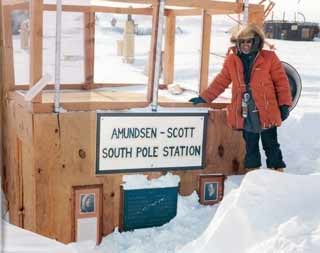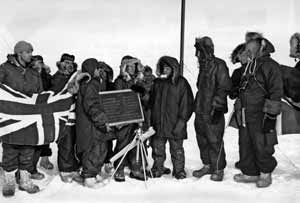Fiftieth Anniversary Ceremony

Closeup of the plaque (in the dome pool room in 2005)
(here's what it looked like in 1980)
[text from the Bulletin of the US Antarctic Projects Officer, Vol. 3 No. 3, November 1961, pp. 3-5.]
|
To commemorate the fiftieth anniversary of the discovery of the South Pole, the Governments of the United Kingdom and Norway proposed to present a grey marble plaque to the Amundsen-Scott South Pole Station. The ceremony of presentation took place at the station on 30 October 1961 (local time). Norway was represented by Dr. Tore Gjelsvik, Director of the Norsk Polarinstitutt, and the United Kingdom by Dr. Gordon de Q. Robin, who is Director of the Scott Polar Research Institute as well as Secretary of SCAR. Mr. Athol Roberts, Leader of Scott Base, represented New Zealand, and Mr. Philip M. Smith, the National Science Foundation. Also present for the occasion were Dr. Paul A. Siple, veteran of the Byrd expeditions and first Scientific Leader at the Amundsen-Scott South Pole Station (1956-57) [sic, see commentary below], and CDR Ronald K. McGregor, USN, Commander, Antarctic Support Activities.
When the C-130 carrying the official party touched down at the South Pole late on 29 October, it was greeted by Rear Admiral Tyree, who had arrived the previous day. The party was then taken to the station mess hall, where Admiral Tyree, opening the ceremony, said: "The deeds of Amundsen and Scott half a century ago are of the greatest significance in man's brief Antarctic history. Both men stand proudly, in the front ranks of those who, in their different ways, have made such vital contributions to the exploration and opening of the Antarctic Continent. Amundsen and Scott laid bare the hinterland of this white continent; they demonstrated that no matter how bitter the elements of nature might be, valiant men could still achieve their goals. Scott and Amundsen added to the sum of man's knowledge; more important, they added immensely to the sum of man's inspiration." Upon the conclusion of his remarks, Admiral Tyree then turned the ceremony over to Dr. Gjelsvik of Norway. During the course of his remarks, the Norwegian polar expert provided some of the basic history surrounding the conquests of the Pole: "Roald Amundsen set out from his base, Framheim, at about 77-1/2 degrees South [sic; see commentary], in the Bay of Whales on October 18, 1911. together with Olav Bjaaland, Helmer Hanssen, Sverre Hassel, and Oscar Wisting. They went straight south and reached the Pole area on December 14, encircling the Pole during the following two days and returning to their base on January 26, 1912. Scott, starting from Ross Island at about 77-1/2 degrees South, a fortnight later than Amundsen, reached the Pole together with E.A. Wilson,
Dr. Gjelsvik went on to say, "As the narrative of Scott's expedition became known to the world, through the publication of his diary and letters, the impact of his expedition changed from that of disaster and tragedy to one of victory and heroism. The magnificent performance of Scott and his men, not life-trained skiers, themselves hauling the sled up the much crevassed Beardmore Glacier, over the windswept plateau to the Pole, and nearly all the way back can well be appraised in Norway, itself a country of mountains, snow, and winter storms." Dr. Robin, in concluding the ceremony's speeches, remarked: "Amundsen and his party, as a result of years of experience in the Arctic and Antarctic, were superb masters of technique. Captain Robert Falcon Scott and his men, of whom his chief scientist, Edward Adrian Wilson, should be especially mentioned, led the world with their attainments in the scientific study of Antarctica. The United States South Pole Station, named after Amundsen and Scott, provides an outstanding example of what can be accomplished by close cooperation between the present day masters of polar technique and the scientists studying natural phenomena at the ends of the earth." The ceremony then moved outdoors to the flagpole where the actual presentation of the plaque was made. Another anniversary event not documented in this article...in December the station was presented with a copy of the famous photograph of Amundsen taking an observation at Pole...which had been donated by the photographer Olav Bjaaland...at the very end of his life (more information). Below, a photo of RADM Tyree addressing the group. From left to right behind the Admiral: Athol Roberts, Leader, Scott Base; Phillip M. Smith, USARP Representative; Dr. Gordon de Q Robin, Scott Polar Research Institute (UK) director and SCAR Secretary; and Dr. Tore Gjelsvik, Norsk Polarinstitutt director. Here is the U. S. Navy caption on the back of the photograph. 
It is not documented where the plaque was originally displayed within the station, but we do know that by 1966 it had a prominent position in the galley (at right, the Memorial Day dinner in 1966) (more info) .  At some point after the holy stairs vestibule was constructed, the plaque was mounted on the west side, along with the annotated prints of Amundsen and Scott, as seen in the 73-74 photo at left. When the domed station was constructed, the plaque was mounted with other station awards in the pool room and library area as seen at right in this 1980 photo along with the Amundsen photo and Admiral Byrd's sweater. These awards were rearranged several times; in 1977 the sweater and some of the other items had been displayed in the galley. Below is the plaque as of January, 2004, displayed below a 1999 plaque commemorating the 70th anniversary of Byrd's November 1929 flight over Pole. CommentaryThe latitude quoted above for the Bay of Whales is presumably a typographical error; what Dr. Gjelsvik certainly said was "78-1/2 degrees south," as Amundsen's start was about a degree of latitude closer to the Pole than Scott's. More precisely, Amundsen said he started at 78°-38'S (the Bay of Whales is, of course, a transitory feature). Scott's official start was from Cape Evans (77°-38'S), but his group left in two parties. Scott's team stopped off at Hut Point (77°-51'S) to regroup; before continuing he phoned back to Cape Evans for someone to bring the forgotten Union Jack. In any case, Amundsen had a distance advantage. The article listed Dr. Paul Siple among the attendees. However, his actual presence is in question since no photographs were taken of him, and attendees PK Swartz and Phil Smith do not recall his presence. The photo of the plaque being held in the galley, titled "Participants..." appeared in the original Bulletin article; however the version seen here is the official US Navy photo from the USAP Antarctic Photo Library. The photo titled "The presentation ceremony, outside at the flagpole" was not in the Bulletin article; this version is from a 2006 Polar Research article Remembering Tore Gjelsvik, 1916-2006 by Olav Orheim (PDF copy). The photo of Ben and PK holding the plaque was scanned from the original Bulletin article. The photo of RADM Tyree speaking is an official US Navy photo by PHC F. Kazukaitis furnished by PK Swartz. The newer photos...the 1966 winter photo is from Cesar Ambalada; the 73-74 photo is by Franz Lazi; the 1980 photos are from Mike Savage; and the 2004 photo is from Seth White. The 2005 photo of the plaque at the top of this page was taken by me in September of that year (larger formats available). |





